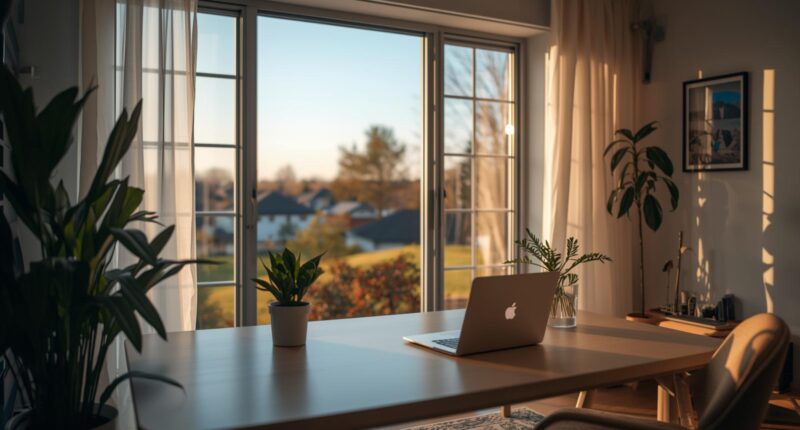Remote Work and Real Estate: Finding a Home That Works for You
The New Work-From-Home Reality
The global shift toward remote work has changed the way people live, work, and buy homes.
No longer tied to city offices, professionals are choosing homes that offer both comfort and productivity.
The intersection of remote work and real estate has created new trends in housing demand — with buyers prioritizing home offices, flexible spaces, and digital infrastructure.
If you’re working from home full-time or part-time, it’s time to find a home that truly works for your lifestyle and career.
How Remote Work Is Transforming the Real Estate Market
The rise of remote work has redefined what people value in a property.
Location is no longer about proximity to an office — it’s about quality of life and convenience.
Key Market Shifts
-
Buyers moving from urban centers to suburban or rural areas
-
Increased demand for larger homes with flexible layouts
-
Focus on reliable internet and digital connectivity
-
Outdoor spaces for relaxation and mental wellness
The work-from-home movement has become a lasting influence on real estate preferences worldwide.
Table – Remote Work Features That Buyers Look For
| Feature | Description | Why It Matters |
|---|---|---|
| Dedicated Home Office | Quiet, private workspace | Boosts productivity and focus |
| High-Speed Internet | Fiber-optic or 5G connection | Supports online meetings and data-heavy work |
| Natural Lighting | Windows and open layouts | Improves mood and reduces fatigue |
| Outdoor Space | Balcony, garden, or terrace | Encourages breaks and relaxation |
| Smart Home Tech | Automation for lights and temperature | Increases convenience and efficiency |
These features have become essential for remote professionals and hybrid workers alike.
Step 1 – Redefine Your Home Priorities
Before the remote work era, homebuyers often prioritized location and commute.
Now, it’s about comfort, flexibility, and balance.
Questions to Ask Yourself
-
How many hours do I work from home each week?
-
Do I need one or multiple workspaces for family members?
-
What helps me stay focused — quiet areas or open views?
-
Is reliable internet available in this neighborhood?
Clarifying your needs helps narrow your search and ensures your new home fits your work-life rhythm.
Step 2 – Choose Locations That Fit Your Lifestyle
With remote work, many professionals are moving to more affordable and lifestyle-rich locations.
Smaller cities, suburban areas, and even coastal towns are seeing growth as buyers look for more space and better living conditions.
Popular Lifestyle Locations
-
Suburban retreats with green surroundings
-
Coastal cities offering scenic views and tranquility
-
Small towns with affordable housing and community spirit
-
Digital nomad hubs with flexible short-term rentals
Explore our full guide — Top Cities for Work-Life Balance and Property Investment.
Choosing a location aligned with your remote work needs and lifestyle goals can improve both productivity and happiness.
Step 3 – Design Your Home Office for Success
Your workspace influences your focus, creativity, and comfort.
A well-designed home office is essential for long-term success in remote work.
Home Office Essentials
-
Ergonomic furniture (desk and chair)
-
Proper lighting (natural and adjustable lamps)
-
Soundproofing for calls and meetings
-
Inspiring décor or greenery
-
Reliable backup power source
Creating a dedicated workspace helps you separate work from personal life and maintain mental clarity.
Step 4 – Evaluate Internet and Tech Infrastructure
A stable internet connection is the lifeblood of remote work.
Before purchasing or renting, check the connectivity strength in the area.
Tips to Ensure Reliable Connectivity
-
Ask for fiber-optic internet availability
-
Test download/upload speeds before moving
-
Consider smart home upgrades for tech integration
-
Use network extenders for large homes
Homes with advanced digital infrastructure hold higher market value for remote professionals.
For updated global broadband rankings, visit Speedtest Global Index to compare internet performance by region.
Step 5 – Prioritize Wellness and Work-Life Balance
Working from home can blur the line between career and personal life.
A home that supports mental and physical wellness ensures balance and longevity in your remote career.
Wellness-Friendly Features
-
Outdoor or garden space for relaxation
-
Nearby parks, gyms, or nature trails
-
Adequate ventilation and natural light
-
Minimal noise pollution and privacy
A calm environment reduces stress and improves productivity — helping you perform at your best daily.
Step 6 – Consider Future Flexibility
The future of work is hybrid.
Choose homes with flexible layouts that can adapt to changing needs — such as new jobs, family growth, or evolving work setups.
Flexible Space Ideas
-
Convertible guest room/office combo
-
Modular furniture for multi-purpose rooms
-
Garage or basement studio for creative work
-
Open-concept designs with zoning partitions
Homes designed for flexibility maintain long-term value in an unpredictable job market.
Step 7 – Invest Smartly for Long-Term Value
Buying real estate for remote work should be both a lifestyle choice and a financial decision.
Choose properties that are not only comfortable but also strong investment opportunities.
Smart Investment Tips
-
Research property appreciation rates
-
Look for communities with growing digital infrastructure
-
Consider rental potential if your remote setup changes
-
Work with realtors experienced in lifestyle-based housing
Smart buying ensures that your remote lifestyle supports your wealth goals, not limits them.
Step 8 – Embrace Community and Connectivity
While remote work provides independence, it can also feel isolating.
Seek neighborhoods that encourage social connection and community life.
Community Benefits
-
Shared co-working spaces within developments
-
Local coffee shops or social hubs
-
Safe, walkable environments
-
Active community events or online groups
Being part of an engaged community helps remote workers maintain motivation and balance.
Conclusion: The Home of the Future Is Designed for Flexibility
The evolution of remote work and real estate proves that the ideal home is one that adapts to your lifestyle, not the other way around.
By prioritizing flexible layouts, wellness spaces, and strong connectivity, you can create a home that supports both career success and personal fulfillment.
As more people embrace digital freedom, the perfect property isn’t just where you live — it’s where you work, grow, and thrive.
The future belongs to homes that empower both your professional goals and your lifestyle dreams.









